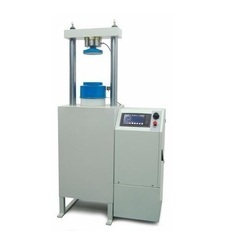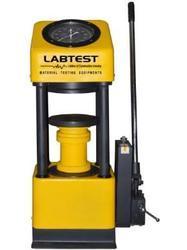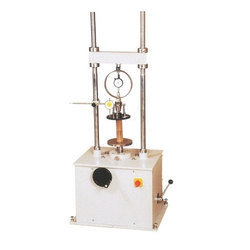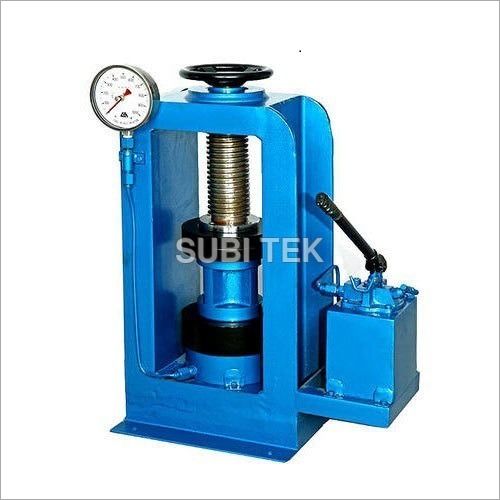Automatic Cement Compression and Flexure Testing Machine
Automatic Cement Compression and Flexure Testing Machine Specification
- Power Supply
- 230V, 50 Hz
- Speed Range
- 0.5 to 5 mm/min
- Capacity
- Compression - up to 2000 kN; Flexure - up to 100 kN
- Stroke
- 50 mm
- Voltage
- 230V AC
- Phase
- Single Phase
- Weight
- Approx 350 kg
- Product Type
- Automatic Cement Compression and Flexure Testing Machine
- Control Mode
- Digital microprocessor based control
- Color
- White
- Display Type
- Digital LCD
- Frequency
- 50 Hz
- Frame Type
- Heavy Duty Welded Steel Frame
- Load Power
- Hydraulic
- Usage & Applications
- Laboratory, Construction material testing
- Accuracy
- 1% of indicated value
- Gauge
- Digital Pressure Gauge
- Dimension (L*W*H)
- 850 x 650 x 1300 mm
- Power
- 1.5 kW
- Features
- High accuracy, automatic operation, safety interlock, data storage, overload protection
- Automation Grade
- Automatic
Automatic Cement Compression and Flexure Testing Machine Trade Information
- Minimum Order Quantity
- 1 Piece
- FOB Port
- Chennai
- Delivery Time
- 2 Week
- Main Export Market(s)
- Asia
- Main Domestic Market
- Dadra and Nagar Haveli, Chandigarh, Himachal Pradesh, Andaman and Nicobar Islands, Uttarakhand, Daman and Diu, Lakshadweep, Nagaland, South India, East India, West India, Andhra Pradesh, Assam, Arunachal Pradesh, Delhi, Gujarat, Goa, Haryana, Jammu and Kashmir, Jharkhand, Karnataka, Madhya Pradesh, Maharashtra, Mizoram, Meghalaya, Manipur, Punjab, Pondicherry, Rajasthan, Sikkim, Telangana, Tripura, West Bengal, Uttar Pradesh, Tamil Nadu, North India, Bihar, Kerala, Central India, Odisha, Chhattisgarh, All India
About Automatic Cement Compression and Flexure Testing Machine
The UTEST Automatic range of single testing chamber and double testing chamber compression and flexure testing machines have been designed for reliable and consistent testing of mortar samples. These compression and flexure testers are the results of continuous applications and research studies to upgrade the machines with the latest technologies and conform the current standards EN 196-1, 459-2, 1015-11, 13454- 2; ASTM C 109, C348, C349 in terms of its technical properties taking into account client requirements by using suitable accessories. These machines also meet the requirements of CE norms for safety and health of the operator.
Tests can be performed by either on UTC-4930.FPR U-Touch PRO Control Unit or on a computer with using USOFT-4830.FPR Software which is provided free of charge with the machines. The advantages of performing tests on computer with using UTEST Software, such as reporting, graphical output, etc. can be seen in detail at the USOFT-4830.FPR pages. (The UTEST Software for Automatic Compression / Flexure Testing Machines with UTC-4830FPR Hydrolic Power Pack)
Dealer in Chennai
Manufacturer in Chennai
Advanced Testing Precision
Designed to meet stringent laboratory requirements, this machine delivers outstanding accuracywithin 1% of the indicated valuemaking it ideal for research, quality control, and compliance testing in construction material laboratories. The digital microprocessor-based control ensures stable operation and repeatable results every time.
Versatile Compatibility and Safety
The machine accommodates both cement cubes and prisms up to 150 mm, providing flexibility for diverse testing protocols. Safety is integral, featuring an emergency stop button, overload protection, and a safety interlock system, all housed in a durable heavy-duty welded steel frame.
Effortless Data Management and Integration
With USB and RS232 data output options, test results are easily transferred for documentation or analysis. The machine is fully compatible with PC data analysis software, streamlining workflow for users seeking efficient laboratory performance and thorough recordkeeping.
FAQs of Automatic Cement Compression and Flexure Testing Machine:
Q: How does the machine ensure precise results during compression and flexure testing?
A: The machine uses a digital microprocessor-based control system and a high-accuracy digital LCD display, ensuring measurements are accurate to within 1% of the indicated value. Full factory calibration is provided so testing can commence immediately with reliable precision.Q: What sample sizes and types can be tested with this machine?
A: This instrument is suitable for testing cement cubes and prisms up to 150 mm in size, making it compatible with standard sample dimensions used in construction material testing laboratories.Q: What safety features are incorporated in this testing machine?
A: For operator safety, the machine includes an emergency stop button, overload protection mechanisms, and a safety interlock system. These features minimize risks during operation and prevent potential equipment or sample damage.Q: When and how should the machine be used for maximum efficiency?
A: The machine is optimized for laboratory use and is ready immediately upon installation and calibration. With an automatic operation mode, operators simply load the sample, set the desired parameters on the digital controller, and begin testing for streamlined workflow and consistent results.Q: Where can I access or store the test data?
A: Test data can be exported via USB and RS232 ports for integration with PC analysis software. This facilitates secure data storage, analysis, and report generation, ensuring efficient laboratory record management.Q: What are the main benefits of using this automatic testing machine over manual alternatives?
A: This automatic testing machine offers high accuracy, repeatability, real-time digital control, and advanced safety features. Its automation and connectivity simplify operation, reduce user error, and allow rapid, precise testing compared to manual machines.

Price:
- 50
- 100
- 200
- 250
- 500
- 1000+
More Products in Compression Testing Machine Category
Digital Compression Testing Machine 2000 KN
Price 160000.00 INR / Piece
Minimum Order Quantity : 1 Piece
Accuracy : 1% of indicated load
Usage & Applications : Material, Concrete and Cement Testing in Laboratory
Features : High precision load cell, Overload protection, Peak hold, Data storage, USB interface
Power : Electronic
Compression Testing Machine (Channel Type Load Frame)
Price 65000 INR
Minimum Order Quantity : 1 Piece
Accuracy : 1% of indicated load
Usage & Applications : For testing compressive strength in laboratory of cement, concrete, bricks etc.
Features : Heavyduty channel type load frame, rigid construction, overload protection, easy operation, high precision gauge
Power : 1 HP (typical for motorized version)
Unconfined Compression Tester (Motorised)
Price 62000 INR / Piece
Minimum Order Quantity : 1 Piece
Accuracy : 1%
Usage & Applications : Laboratory; for determination of Unconfined Compressive Strength of Soil
Features : Consists of loading unit with long travel (50 mm), fitted with lead screw and adjustable platform. Dial gauge for deformation measurement. Solid and robust construction.
Power : AC Motor Driven
Compression Testing Machine
Price 38000 INR / Piece
Minimum Order Quantity : 1 Piece
Accuracy : 1%
Usage & Applications : For measuring compressive strength of concrete cubes, cylinders, bricks etc.
Features : Robust design, High precision gauge, Safety guards, Easy operation
Power : Electricoperated
GST : 33AVTPM1866A3ZI
|
 |
SUBI TEK
All Rights Reserved.(Terms of Use) Developed and Managed by Infocom Network Private Limited. |


 Send Inquiry
Send Inquiry





